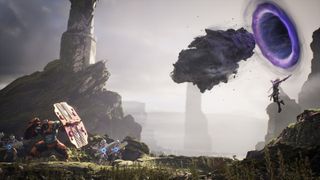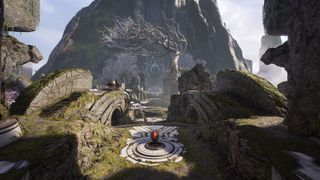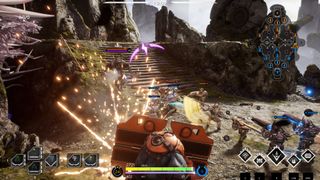
Chris: the MOBA veteran
I definitely recognise Paragon in James’ description of it, but my experience was wildly different—and much more positive. I came at the game from the opposite direction. I kept expecting Paragon to be more of an action game than it actually is, and found myself pleasantly surprised by how much it feels like Dota. I was a pretty big fan of Gears of War and Unreal Tournament, so when I see Epic-brand battle-dudes I expect a certain pace and lethality. Instead, I found a game that is surprisingly slow, deep, and strategic.
Let’s start by talking about what’s different. The verticality of the map is something genuinely new, and distances Paragon from Smite—the game it’s otherwise closest to in feel. There are three lanes and a jungle, but each of these things occupies a different elevation and is surrounded by mountains, ridgelines, and hidden pathways. You can be fighting on the top lane (literally the ‘top’ lane) and look down towards mid to check on your teammate there—a little like checking the minimap, without the minimap. The jungle is deep underneath a tree canopy that obscures your line of sight from lane, allowing you to disguise rotations and escape a teamfight gone wrong.
Paragon inherits Smite’s need for 360-degree awareness, and compounds it with the use of three-dimensional space. I spent one long, tough, satisfying game as the support tank Steel: his ultimate is a leaping smash that stuns enemies in an AoE. I made a game of appearing on ridgelines, even when my ult was down, in order to force my opponent to play cautiously. If you’re up there, you look like you’re getting in position to drop the hammer. And you might be. Or you might not be. And those kinds of mind games are exactly why I love this genre.

Old dogs
Against this novel backdrop, Paragon’s character designs strike me as actually rather traditional. Steel has that AoE stun ultimate, a dash/knockback, and a deployable shield that grants protection to allies and slows enemies. Another support, Dekker, has a slow field, a skill shot stun/nuke, and her ultimate creates an impassable circular fence to restrict enemies to a certain area. The mage Gideon has a skillshot nuke, a teleport, and a big teamfight ult—he’s a natural midlaner. Twinblast, a carry, has an AoE nuke/slow—utility and wave-clear, basically—and the rest of his kit amount to damage-boosting steroids of various sorts.
The switch to third person has as a subtle influence in each case. Steel can hold his shield out in front of him to block damage in a direction, and you can do this while strafing and moving backwards to allow allies to disengage—something that isn’t possible in an isometric MOBA. Dekker has a jetpack. Gideon’s teleport can be fired in three dimensions. Twinblast actually has to, y’know, aim at the people he’s shooting at. Even so, my predominant feeling was ‘I know how all of this fits together’. I managed to score a solo first blood as Dekker because two-thousand-something hours of Dota 2 have taught me that slows are really, really good in the early game. That kind of thing.
There are new ideas in Paragon that would work in any game of this type. Enemy towers, for example, have an indicator that shows how many friendly creeps are currently in their firing range. This lets you know exactly when you need to back out before drawing fire yourself. Consumable items—health potions, mana, wards, etc—are bought once, and have a stock of charges that are replenished when you return to base. Once you’ve picked them up once, you don’t need to invest any more in them until you eventually swap them out to use the inventory slot for something more powerful. These are solid design decisions, and indicative of thoughtful design throughout. I really dislike the phrase 'just another MOBA' because getting these things right—subtle as they might seem—is hard.

New tricks
I’m still not 100% sold on the card system, however. The easiest way to think about it is as an item store that you populate in advance of the game by building a deck. You can build a deck that accounts for a lot of different possibilities, or decide in advance that you’re going to push in a particular direction—damage, cooldown reduction, armour, etc—and double-down on whatever that is. This may work well for new players, because the most complicated decisions are presented to you outside of the game. You build your deck in the quiet of the main menu in order present yourself with a simpler set of decisions in the heat of a match. On the other hand, it’s a lot of information to take in and a lot to consider without context. And if the enemy does something unexpected and you don’t have the deck to deal with it, there’s nothing you can do. Epic have a real challenge ahead of them in order to ensure that the deck system doesn’t devolve into (a) a series of must-have builds or (b) luck of the draw in terms of counters.
The biggest gaming news, reviews and hardware deals
Keep up to date with the most important stories and the best deals, as picked by the PC Gamer team.
Some of this risk is mitigated by the way that passive items work. Most take the form of a shell item with three slots, and the nature of item determines what bonuses can be placed in those slots. A staff might take cooldown reduction, ability power and energy regen, for example, but you can adjust the exact weighting of those bonuses based on the cards that you subsequently insert. Then, when the item is ‘finished’, it gains an additional attribute—a little like a set bonus in an MMO. As Steel, for example, I was encouraged to stick three health-boosting cards into my armour because I’d get an armour boost for free when it was finished, and there’s no arguing with raw hitpoints. There’s a lot of depth there, a lot to consider, and I felt like I was just scratching the surface when my session was done.
The best thing I can say about Paragon is that I forgot that I was a journalist testing a game when I was playing it. One close-fought game took a full hour (the average is closer to thirty minutes) and drew a crowd; I really wanted to win, and had to dig deep into my Tryhard Dota Brain to get there. It generated stories: base-races and clutch defenses, the Gideon ultimate that turned the game, the time my tanked-up Steel drew the entire enemy team on a long, silly, slow chase across the entire length of the map. This is what I come to MOBAs for, and I’ve tested a lot of MOBAs, and in those moments I forgot where I was and simply enjoyed the game on its own terms. I’d love it if newcomers could see what I see in it, but—somewhat selfishly—it’s nice to feel like somebody is making a game just for you.
PC Gamer is the global authority on PC games—starting in 1993 with the magazine, and then in 2010 with this website you're currently reading. We have writers across the US, Canada, UK and Australia, who you can read about here.
Most Popular

